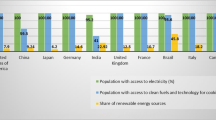Abstract
The diffusion of renewable energy sources is an important policy issue for all countries. In particular, feed-in tariffs (FITs) are a major policy instrument used to diffuse renewable energy sources in developed countries. A few recent studies have found a rebound effect from the installation of solar photovoltaic (PV) systems. However, consumer behavior in relation to electricity consumption following the installation of solar PV systems is largely unknown. In particular, previous studies do not effectively reveal the FIT effect on electricity consumption. Therefore, we set up a model to measure this effect and conduct empirical analysis to confirm the theoretical contribution of the improved model. Our estimation results based on the matching method show that the FIT scheme increases the consumption of electricity purchased from electricity companies if the FIT rate exceeds the electricity price. This finding is important for better understanding the true cost-benefit of FITs.
Similar content being viewed by others
Notes
Since the end of the official FITs, a voluntary FIT program has been implemented in some states.
The respondents who answered that their income equals zero may have answered incorrectly or may not have wanted to reveal their income. This is another reason we omit the data of such respondents.
After we omit samples who answer that their income is equal to zero, the total sample becomes 8,101. Additionally, some variables include missing values because the respondents do not answer. Table 2 show detail about the number of observations of each variable.
The summary statistics of each group are shown in Appendix 2.
As mentioned above, we also run another regression model that includes the attributes as independent variables. We show the results in Appendix 3.
We implement Wald test between estimated coefficients of FIT_ele in Table 5. The test results do not show significant differences between the coefficients.
In this estimation, we add the cross term to model 1 in the previous section.
References
Australian Bureau of Statistics (2012) Household Energy Consumption Survey
Australian Energy Council (2018) Feed-in tariffs: State by state. https://www.energycouncil.com.au/media/12974/feed-in-tariffs-state-by-state.pdf. Accessed 20 Feb 2021.
Australian Energy Market Commission (2017) 2017 Residential Electricity Price Trends. https://www.aemc.gov.au/sites/default/files/content/bf56a5d5-e2b2-4c21-90ed-79dda97eb8a4/2017-Residential-Electricity-Price-Trends.pdf. Accessed 20 Feb 2021
Blackwell M, Iacus SM, King G, Porro G (2009) Cem: coarsened exact matching in Stata. Stata J 9(4):524–546
Borenstein S (2008) Equity effects of increasing-block electricity pricing. https://escholarship.org/uc/item/3sr1h8nc. Accessed 20 Feb 2021
Chapman AJ, McLellan B, Tezuka T (2016) Residential solar PV policy: an analysis of impacts, successes and failures in the Australian case. Renewable Energy 86:1265–1279
Deng G, Newton P (2017) Assessing the impact of solar PV on domestic electricity consumption: exploring the prospect of rebound effects. Energy Policy 110:313–324
Energy Matters (2020) Information on Australian solar feed-in tariffs. https://www.energymatters.com.au/rebates-incentives/feedintariff/. Accessed 20 Feb 2021
Gneezy U, Rustichini A (2000) A fine is a price. J Legal Studies 29(1):1–17
Grafström J, Lindman Å (2017) Invention, innovation and diffusion in the European wind power sector. Technol Forecasting Social Change 114:179–191
Hitaj C, Löschel A (2019) The impact of a feed-in tariff on wind power development in Germany. Resource Energy Econ 57:18–35
Hortay O, Rozner BP (2019) Allocating renewable subsidies. Econ Anal Policy 64:236–247
Ito K (2014) Do consumers respond to marginal or average price? Evidence from nonlinear electricity pricing. Am Econ Rev 104(2):537–563
Jessoe K, Rapson D (2014) Knowledge is (less) power: experimental evidence from residential energy use. Am Econ Rev 104(4):1417–1438
Keeley AR, Matsumoto K, Tanaka K, Sugiawan Y, Managi S (2020) The impact of renewable energy generation on the spot market price in Germany: ex-post analysis using boosting method. Energy J. https://doi.org/10.5547/01956574.42.S12.akee
King G, Nielsen R (2019) Why propensity scores should not be used for matching. Political Anal 27(4):435–454
Langer A, Lemoine D (2018) Designing dynamic subsidies to spur adoption of new technologies. National Bureau of Economic Research No. w24310
Lenzen M, Dey C, Foran B (2004) Energy requirements of Sydney households. Ecol Econ 49(3):375–399
Nelson T, Pascoe O, Calais P, Mitchell L, McNeill J (2019) Efficient integration of climate and energy policy in Australia’s National Electricity Market. Econ Anal Policy 64:178–193
Macintosh A, Wilkinson D (2011) Searching for public benefits in solar subsidies: a case study on the Australian government’s residential photovoltaic rebate program. Energy Policy 39(6):3199–3209
Martin N, Rice J (2013) The solar photovoltaic feed-in tariff scheme in New South Wales, Australia. Energy Policy 61:697–706
Qiu Y, Kahn ME, Xing B (2019) Quantifying the rebound effects of residential solar panel adoption. J Environ Econ Manag 96:310–341
Rai A, Nunn O (2020) On the impact of increasing penetration of variable renewables on electricity spot price extremes in Australia. Econ Anal Policy 67:67–86
Ritzenhofen I, Spinler S (2016) Optimal design of feed-in-tariffs to stimulate renewable energy investments under regulatory uncertainty—a real options analysis. Energy Econ 53:76–89
Ryan AJ, Donou-Adonsou F, Calkins LN (2019) Subsidizing the sun: the impact of state policies on electricity generated from solar photovoltaic. Econ Anal Policy 63:1–10
Sekitou M, Tanaka K, Managi S (2018) Household electricity demand after the introduction of solar photovoltaic systems. Econ Anal Policy 57:102–110
Tanaka K, Sekito M, Managi S, Kaneko S, Rai V (2017) Decision-making governance for purchases of solar photovoltaic systems in Japan. Energy Policy 111:75–84
UNEP (2012) Feed-in tariffs and a policy instrument for promoting renewable energy and green economics in developing countries. https://wedocs.unep.org/handle/20.500.11822/8102. Accessed 20 Feb 2021
Webb J, de Silva HN, Wilson C (2020) The future of coal and renewable power generation in Australia: a review of market trends. Econ Anal Policy 68:363–378
Acknowledgements
We gratefully acknowledge financial support from the Grant-in-Aid for Scientific Research (JSPS KAKENHI JP17K13737 and JP20H00648).
Author information
Authors and Affiliations
Corresponding author
Additional information
Publisher's Note
Springer Nature remains neutral with regard to jurisdictional claims in published maps and institutional affiliations.
About this article
Cite this article
Tanaka, K., Wilson, C. & Managi, S. Impact of feed-in tariffs on electricity consumption. Environ Econ Policy Stud 24, 49–72 (2022). https://doi.org/10.1007/s10018-021-00306-w
Received:
Accepted:
Published:
Issue Date:
DOI: https://doi.org/10.1007/s10018-021-00306-w




